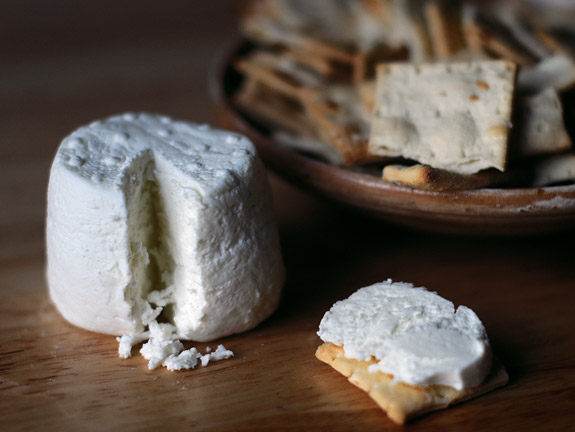After a winter’s break, the goats at Rhonda Gothberg’s farm have kidded and their milk is rich and sweet. The soft French-style cheese she makes is delicious with just a nuance of that goat tang. Maybe it’s because the animals have added tender green grass to their diet, maybe it’s because it has been a long winter without fresh goat cheese, but “June chèvre is my favorite,” says Gothberg.
With a few acres in Skagit Valley, Gothberg is raising 29 milk goats for her farmstead cheese business. Early each the morning, just as the sun illuminates the shape of Chuckanut Mountain in the near distance to the north, she heads out her back door to her flock.

But before she gets to the goats, she dons a clean white lab coat, shoe covers, and a cap and makes a right into the cheese room where fresh mounds of white, smooth chèvre wait to be turned.
Making cheese is a most satisfying process, says Gothberg. Collecting and cooling the milk and adding veal rennet, she makes the cheese one day and lets it sit overnight. The next day she turns it and then lets it sit another night. Within three days, it’s ready. She calls it “go out fast” cheese.
While goat’s milk and cow’s milk have a lot in common, goat’s milk has volatile short chain fatty acids, which give it those unique flavors, says Stephanie Clark, a food scientist at WSU. “Those are really rancid notes. They’re more piquant or peppery. Some people don’t like that.”
When it comes to making cheese, goat’s milk is definitely harder to work with. Its milk fat globules are very fragile; their membranes can be broken by temperature and rough handling. The sign of a good goat cheese, and good handling, is its mildness, says Clark. And because it has less alpha-s1 casein protein, goat cheese is typically softer than cow’s cheese.
Gothberg’s La Mancha goats wait in three small pens in the barn, knowing it will just be a few minutes before she leads them up the metal ramp to the milking station. Brown and black and grey, with sleek heads and small ears, these goats are a variety bred in the 1930s in California and known for their sturdy constitutions and flavorful milk.
Gothberg doesn’t have to prod her goats, she just talks to them gently and the first five—Ditto, Alice, Winona, Hanna, and Liza—willingly move up the ramp. “As soon as they see me, they’re ready to go,” she says. She particularly likes this breed’s affable nature. “They’re smart, inquisitive, tuned in to you,” she says. “It’s like having 29 kindergarteners.”
Though she had never milked an animal in her life, Gothberg first purchased a doe and a kid in 2002 with the notion of making cheese as a hobby. The goats suited her schedule as a real estate agent, and cheese making proved a great creative outlet. The next year she added two more females, and more the year after. She honed her cheese-making skills in her farmhouse kitchen, then enrolled in Washington State University’s cheese-making clinic. As soon as she realized she could turn the hobby into a business, she built a new barn with a milk storage room and a cheese room.
Gothberg is also a registered nurse. That background came in handy when it came to building her cheese facility. She works religiously to meet—and exceed—health department requirements. The milk goes straight from the goat through a sanitized hose into the clean milk room, where it is quickly cooled and pasteurized. Then it’s moved one door further to the cheese room, where it is poured into the molds and later salted and turned.
But because she was one of the first small operations to pop up in several years, Gothberg struggled to find equipment to suit her size. “I had to figure out how to cool milk without using a bulk tank,” she says. A bucket in a bath of ice water worked nicely.
Now other small-scale dairies are following Gothberg’s model. Washington is seeing a boom in artisan cheese-making operations, says Russ Salvadalena, manager of WSU’s creamery. There is now so great a demand for the University’s annual cheese class that the school has had to add another three to four courses each year. “It got to be that the farmstead cheese makers took up half the class,” says Salvadalena. “We had to turn people away.”
Marc Bates, ‘70, who was the University’s creamery manager before Salvadalena, teaches basic cheese-making courses in Western Washington, Idaho, and Oregon. He has seen an exponential rise in artisan cheese makers. “We’re seeing cow dairies trying to add value and get more income from their milk, and we’re seeing goats be the most popular next animal.” Sheep are joining the scene as well, he says.
California may have led the cheese revolution, particularly with goat cheese when in the 1980s farmer/cheese maker Laura Chenel made it part of the American palate. Since then the trend of handcrafting cheese has crept up the coast from Sonoma to British Columbia. “We’ve gone from less than 10 licensed facilities in Washington back around 2000 to over 30 that are now licensed and making cheese,” says Bates.
It’s a good time to be a cheese eater. “Cheese is doing just what the beer industry did,” says Bates. “It had consolidated to the point where there were only a few choices and—voilá, opportunity.” Because beer was so standardized, there was room for a microbrewing rage. “Now we see the farmstead cheese movement taking off,” he says.
Why did it take cheese longer to do this than beer? “Maybe cheese making is harder than beer making,” he says. “But they do go well together.”

